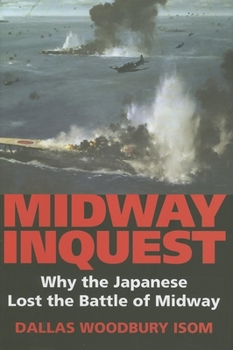Midway Inquest: Why the Japanese Lost the Battle of Midway
(Part of the Twentieth-Century Battles Series and Twentieth-Century Battles Series)
Select Format
Select Condition 
Book Overview
Midway, the most famous naval battle in American history, has been the subject of many excellent books. However, none satisfactorily explain why the Japanese lost that battle, given their overwhelming advantage in firepower. While no book may ever silence debate on the subject, Midway Inquest answers the central mystery of the battle. Why could the Japanese not get a bomber strike launched against the American carrier force before being attacked...
Format:Hardcover
Language:English
ISBN:0253349044
ISBN13:9780253349040
Release Date:July 2007
Publisher:Indiana University Press
Length:432 Pages
Weight:1.44 lbs.
Dimensions:1.2" x 6.3" x 9.3"
Age Range:18 years and up
Grade Range:Postsecondary and higher
Related Subjects
HistoryCustomer Reviews
2 ratings
Well Written
Published by Thriftbooks.com User , 16 years ago
Finally someone who is a fine writer presents Nagumo as a good and decisive leader. Factual and well presented!
New MIdway revelations with a few arguable conclusions
Published by Thriftbooks.com User , 17 years ago
Clearly, the Battle of Midway is the most chronicled single event in the U.S. Navy's history. Six decades of books, media productions and scholarly studies on it would seem to have covered every conceivable fact that can possibly be analyzed and reported. At this late date, then, researchers face an intimidating challenge in coming up with anything new as to how and why the battle turned out as it did. Midway Inquest is author Dallas Isom's attempt to do just that, and he largely succeeds. Isom, a law professor at Willamette University, initially presented his thesis (that Japanese carrier admiral Chuichi Nagumo was befuddled by circumstances largely beyond his control) in 2000 via a detailed treatise in the Naval War College "Review." That article was something of a groundbreaker in Midway historiography, for it included a fresh analysis of certain key evidence coupled with original revelations that brought important new understandings of Nagumo's woes as the battle unfolded. Midway Inquest is the author's NWC article expanded into book form, with abundant supporting data and supplemental text. The book's subtitle, "Why the Japanese Lost the Battle of Midway," may appear rather simplistic to casual students of the battle, for those facts have long been assumed. But Isom believes that there is much more to the story, and that certain elements of the classic explanation for Japan's defeat at Midway are wrong. He bases his theories on several interviews with Japanese veterans and extensive review of primary documents in Japan. The result is two rather significant findings that Isom brings to the Midway discussion. Number one, his Japanese interviews were focused more on the enlisted mechanics who worked on the carriers' hangar decks than on the pilots who are the usual focus of interviewers. That gave Isom a highly detailed understanding of exactly how, for example, a torpedo was mounted on a B5N2 torpedo bomber ("Kate"), and especially what was involved in removing one, replacing it with a land bomb, and then reversing the procedure. It turns out that such minor details were a very important factor in Nagumo's decision process as the carrier battle commenced, which leads the reader to a far better understanding of why the admiral could not get an air strike launched before it was too late. The second new revelation concerns the renowned flight of the cruiser Tone's number 4 scout plane which, to Nagumo's supreme consternation, reported an American carrier in his vicinity. Tone 4 had launched thirty minutes behind schedule due to mechanical trouble, leading many Midway authors to conclude that Japan would have won the battle if the scout had launched on time. A half hour advance notice that an American carrier was nearby would have given Nagumo a head start in rearming his Kates, with the result that a full strike could have been launched before American dive bombers arrived overhead. But Isom's analysis of Tone 4's track and the time of its con






